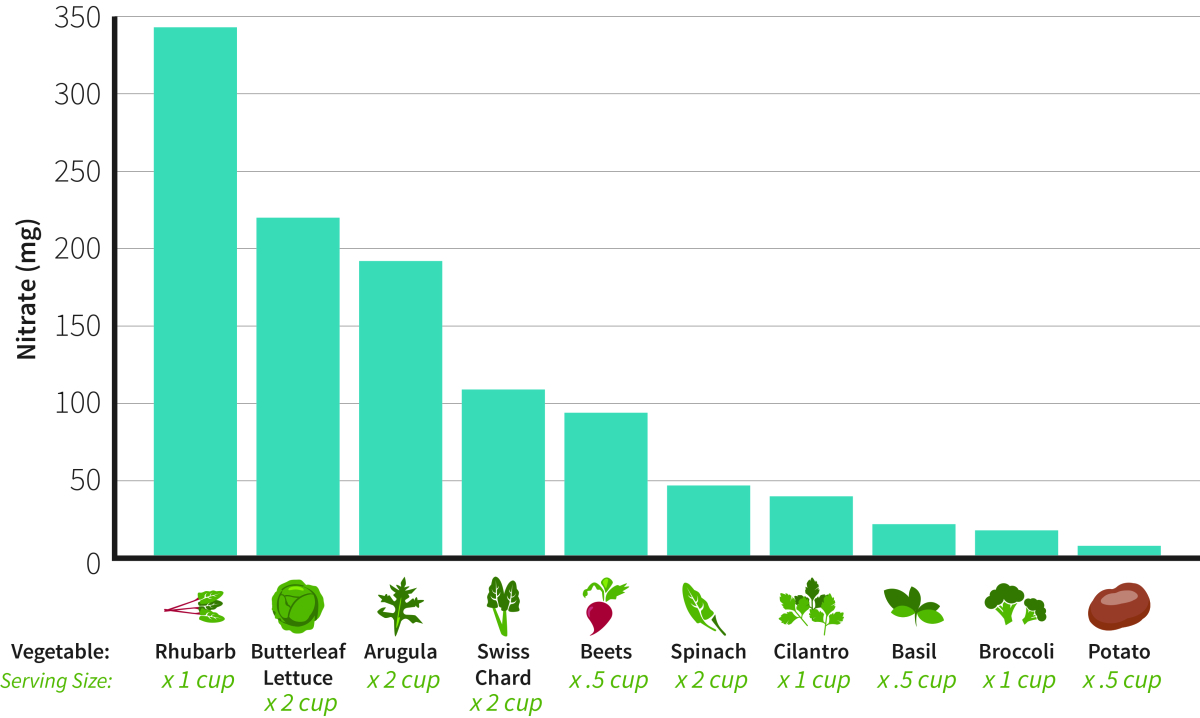Berkeley Fit Blog
Nitrate-rich plant-based foods may explain the blood pressure reducing effects of the DASH Diet
With age and a sedentary lifestyle, daily consumption of nitrate-rich leafy greens coupled with physical exercise is an effective way to elevate naturally occurring nitric oxide, the body’s natural cardio-protective factor.
Several clinical studies consisting of over 200+ participants consuming beet juice with 360-400 mg nitrate per serving size/day resulted in blood pressure reduction of 4-11 mmHg and a restoration of endothelial function in hypertensives (1-4).
While the body does produce nitric oxide naturally inside healthy endothelial cells from the amino acid L-arginine, the most significant source is actually dietary nitrates, found in spinach, arugula, collard greens and beets among other leafy greens, which friendly bacteria in your mouth begins the transformation of plant-derived nitrate to nitric oxide.
 By following the Dietary Approach to Stop Hypertension diet (DASH Diet), you may can exceed 1,000 mg/day of inorganic nitrate derived from leafy greens which may explain the blood pressure lowering effects (5). The researchers not only linked the consumption of nitrate-rich plant foods to the blood pressure lowering effects of the DASH Diet but concluded that dietary inorganic nitrate should be considered a necessary nutrient in our daily diet.
By following the Dietary Approach to Stop Hypertension diet (DASH Diet), you may can exceed 1,000 mg/day of inorganic nitrate derived from leafy greens which may explain the blood pressure lowering effects (5). The researchers not only linked the consumption of nitrate-rich plant foods to the blood pressure lowering effects of the DASH Diet but concluded that dietary inorganic nitrate should be considered a necessary nutrient in our daily diet.
Nitric Oxide-potent vegetables, such as leafy greens and beets -- rich in inorganic nitrate -- lowered blood pressure as effectively as antihypertensive medication. Other reports have suggested that the conversion of dietary inorganic nitrate from leafy greens to nitric oxide reverses cardio-metabolic problems, such as obesity, type 2 diabetes, and fatty liver.
Unfortunately, dietary adherence to nitrate-rich plant-based diets, rich in leafy greens, remains an obstacle. Data from major cohort studies suggest that 80% of cardiovascular disease and 91% of diabetes risk may be prevented by changes in diet and lifestyle. The scientific recommendations of the U.S. Dietary Guidelines Advisory committee advocate the therapeutic diet, Dietary Approaches to Stop Hypertension (DASH) and Mediterranean Diet. Yet despite efforts to encourage the public to increase plant food consumption of nitrate-rich foods, the response has been slow.
A randomized study published in the American College of Cardiology journal confirmed that adhering to diet recommendations lead to benefits in coronary heart disease risk factors but unfortunately, found that changing eating habits proved the most difficult. “These data demonstrate the difficulty in effectively promoting fruit and vegetable to the general population, using recommendations that, when followed, decrease risk factors for chronic disease,” the researchers wrote. “They indicate an urgent need for innovative approaches to support the implementation of current dietary advice.”
- Ashworth A, Mitchell K, Blackwell JR et al. High-nitrate vegetable diet increases plasma nitrate and nitrite concentrations and reduces blood pressure in healthy women. 2015. Public Health Nutr. 16: 1-10.
- Gee LC, Ahluwalia A. Dietary Nitrate Lowers Blood Pressure: Epidemiological, Pre-clinical Experimental and Clinical Trial Evidence. Curr Hypertens Rep. 2016 Feb;18(2):17.
- Lara J, Ashor AW, Oggioni C, Ahluwalia A, Mathers JC, Siervo M. Effects of inorganic nitrate and beetroot supplementation on endothelial function: a systematic review and meta-analysis. Eur. J Nutr. 2016 Mar;55(2):451-459.
- Siervo M, Lara J, Ogbonmwan I, Mathers JC. Inorganic nitrate and beetroot juice supplementation reduce blood pressure in adults: a systematic review and meta-analysis. J Nutr. 2013 Jun;143(6):818-26.
- Hord NG, Tang Y, Bryan NS. Food sources of nitrates and nitrites: the physiologic context for potential health benefits. Am J Clin Nutr. (2009) 90: 1-10.